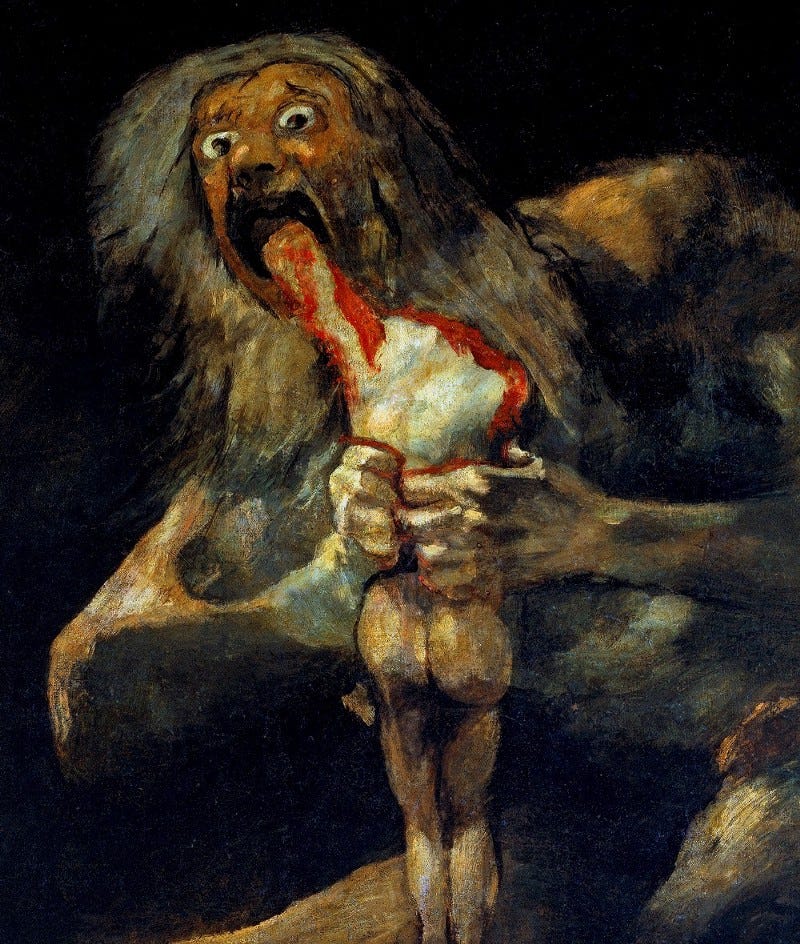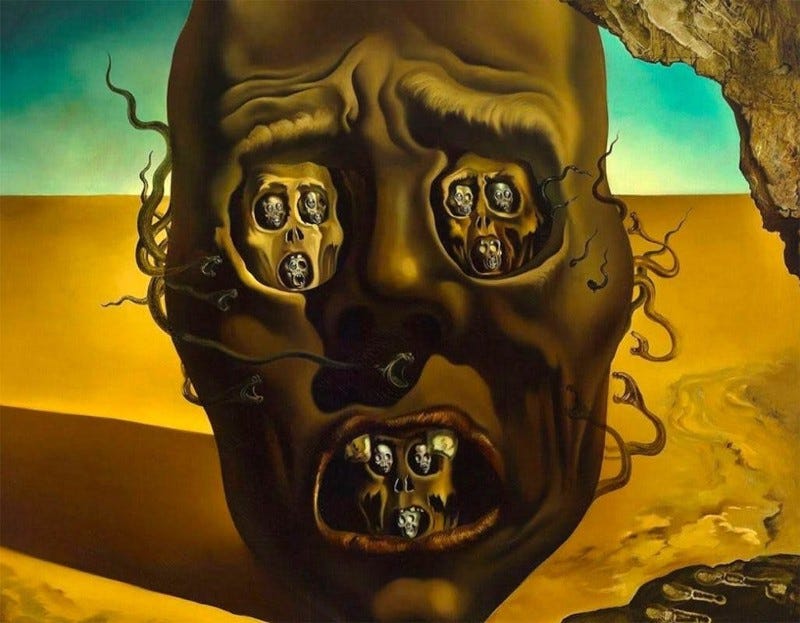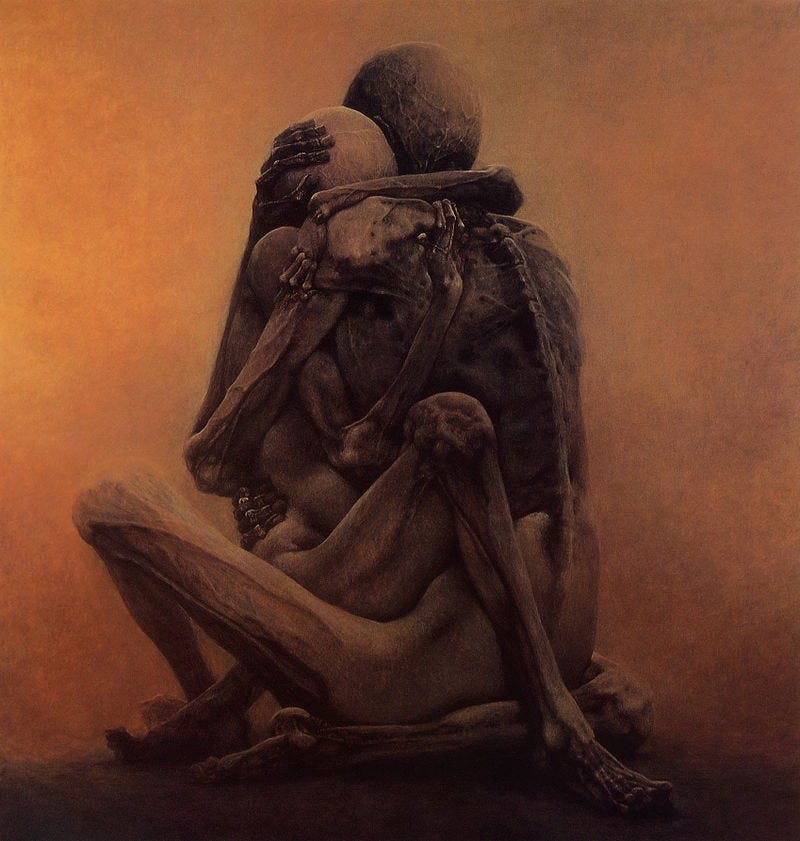5 Frighteningly Beautiful Paintings That Would Leave You Anxious
Edition #25 - Why do we hate to love tragedy?
Hey friends,
By the time you receive this newsletter, I’ll be in India to attend my brother’s wedding. I’m super excited to be a part of this mega family celebration.
Coming to this week’s newsletter, I’ll talk about 5 macabre paintings by 5 famous artists and understand the psychology behind each one of them.
5 Frighteningly Beautiful Paintings That Would Leave You Anxious
Why do we hate to love tragedy? It could be a horror movie, a true-crime docuseries, or a nightmarish painting. The other day I saw a disturbing documentary on Netflix. I knew it was unsettling, but I kept binge-watching it anyway and felt disgusted afterward.
Why do we romanticize macabre?
There isn’t a single reason but a mnemonic per se. We want to S.C.R.E.A.M for Strength, Catharsis, Reality, Exploration, Acceptance, and Meaning.
It is often seen in the art realm that famous artists have tried to quench their anxieties by portraying the monstrous, evil, and dark aspects of life on canvas. Be it Vincent van Gogh, Francisco Goya, or Edvard Munch.
So, here are 5 dark paintings that might scare you, make you anxious, or even haunt you, but we can’t get away from them.
1. Saturn Devouring His Son by Francisco Goya

Swiss psychiatrist Carl Gustav Jung says, “One does not become enlightened by imagining figures of light, but by making the darkness conscious.”
Goya’s Saturn Devouring His Son tops all lists of grim, gory, gruesome, and ghastly paintings. Saturn, the demonic figure with protruding eyes, is swallowing the body of his own child. His fear that he would one day be overthrown by one of his own children results in him eating them one by one upon their birth.
But what we are not familiar with is that this mural was placed in Goya’s villa’s dining room and other Black paintings.
The most disturbing image in Western art was found in his personal space, directly painted on the wall. And on top of it, he left no notes and titles for these artworks. Why?
By 1819, Goya had gone through a lot. His solitude, physical illness, fear, and hysteria gave rise to the creation of Black Paintings.
2. Dante and Virgil by William by Adolphe Bouguereau

This is one of those ghastly images you might want to ignore, but you simply can’t. Yes, it's that powerful.
The image reveals Dante’s and Virgil’s journey to the eighth circle of hell. They stop to see brutal combat between two naked men.
The attacker, Gianni Schicchi, is a fraud who disguises himself as a dead man and savagely bites the neck of the victim, and brutally kneels his back. The victim, Cappocchio, is a heretic and alchemist. This was when heresy and alchemy were sins, and hell was the final destination.
The painter, Adolphe Bouguereau, has exceptionally captured the Dracula moment, showcasing Schicchi’s strength, the fluidity of the men’s poses, and Dante and Virgil's shocking expressions. Virgil is feeling so pukish he puts a piece of his own garb cloth on his mouth.
3. Untitled by Zdzislaw Beksinski
I feel that the best way we can connect with a painting is by understanding the psychology behind the artwork.
Why was the artwork created?
What instigated the artist to draw such a dark image?
Zdzislaw Beksinski was a Polish artist who created paintings filled with elements of dystopia, doomsday, and destruction of the world. He intentionally left his paintings untitled because he felt art was only to be admired without giving a name or interpretation to it.
In the Nazi era, Beksinski personally encountered antisemitism and the mass killings of thousands of Jews. It created a black hole in his psyche.
But this untitled image shows that even after experiencing the worst of humanity, he portrayed love and embrace between a skull couple in the facade of a catastrophic backdrop. Isn’t it frighteningly beautiful?
4. Massacre of the Innocents by Peter Paul Rubens

There are a plethora of creations around this subject. But Peter Paul Rubens’s composition kept me engaged for the longest time.
The Massacre of the Innocents depicts the ruthless portrayal of infanticide, which — according to the Bible’s Gospel of Matthew — was an actual incident.
This painting showcases a disturbing ability to pull the viewer into the scene, whether a fact or legend. In the New Testament, the Judean King Herod the Great ordered the mass killings of male infants aged two years and under in Bethlehem.
King Herod was skeptical that he might have to give away his crown because of the birth of a male child or being mocked by The Magi — aka The Three Wise Men.
5. The Face of War by Salvador Dalí

It is for the benefit of humanity to mitigate the horrors of war as much as possible.
War has brought no good and will get no good to humankind. It only leads to loss, suffering, and misery.
Dali’s The Face of War is a surrealist representation condemning the war. The snakes are an allegory to terrorists who kill innocent people. The eyes and the mouth are clogged with a group of skulls because that is what ultimately war leads to — dystopia.
If by any chance these paintings made you uneasy, I’d like to leave you with a beautiful quote to ponder upon —
“He who fights monsters should see to it that he himself does not become a monster. And if you gaze for long into an abyss, the abyss gazes also into you…” — Friedrich Nietzsche
Thank you for subscribing and supporting my newsletter. Both free and paid subscriptions are available. The best way to support my work is through a paid subscription.
And yeah, here’s my free e(book). Download your copy now.





So relevant to see today